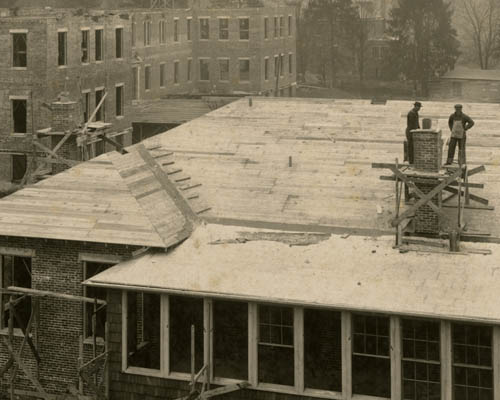Tennessee School for the Deaf
Photographs of the Tennessee School for the Deaf, which has operated since 1845 in Knoxville.
Tennessee’s School for the Deaf, created by law in 1844, boasts a remarkably long and stable history of educating the state’s students with hearing disabilities. The school has operated since 1845 in Knoxville, closing only for the Civil War and relocating only once (from downtown to an inner suburb). This unit of the Tennessee Virtual Archive features images of this unique institution’s buildings, many of which were designed by noted architect and alumnus Thomas Scott Marr.
Few such long-established educational institutions in Tennessee are given such little notice as the Tennessee School for the Deaf in Knoxville. Established by the General Assembly in 1844 and in operation since 1845, the School for the Deaf has offered a boarding-school education for many generations of deaf students. Although the school may not have a high profile across the state, its presence fills a vital niche in the education of a special demographic of Tennessee schoolchildren.
According to the 100th Anniversary of the Tennessee School for the Deaf, 1845-1945, credit is given to Grainger County Senator Gen. John Cocke for leading the campaign to establish a School for the Deaf in the state. Nashville already offered a private school for the blind, but it was not until January 29, 1844, that Tennessee officially created and funded state-sponsored schools for the blind (in Nashville) and deaf (in Knoxville).
By design, the built environment of the Tennessee School for the Deaf fosters a community in which students live, learn, and play. Because the school serves the entire state, most children reside during the school year in intimate cottages and somewhat larger dormitories that dot the school’s campus. These buildings, many of which are displayed in this collection, offer human-scaled living conditions unlike the grand and imposing Gothic-styled architecture typical of many boarding schools. The bucolic setting of the Island Home neighborhood, an early Knoxville streetcar suburb, provides an ideal campus separate from the bustling commercial and academic areas of the city and the University of Tennessee, which dominates parts of Knoxville.
Perhaps the most outstanding of the Tennessee School for the Deaf’s alumni was also the architect of many of the school’s buildings. Thomas Scott Marr (1866-1936) attended the school for his primary and high school education until 1884; he then enrolled at Washington’s Gallaudet University, from which he graduated in 1889. Marr also studied at the Massachusetts Institute of Technology. His Nashville firm, Marr and Holman, designed a host of Nashville and nearby structures, many of which stand today. Visitors to downtown Nashville can visit the city’s grand Art Deco post office (repurposed as the Frist Center for the Visual Arts) on Broadway and the Tennessee Supreme Court Building, which sits next door to the State Library and Archives on Capitol Hill. Marr’s designs for several buildings on the Tennessee School for the Deaf campus, on display in this collection, leave a tangible reminder of his legacy and offer inspiration for students with lofty aspirations.
Although not designed by Marr, a noteworthy edifice on the school’s campus has served as the superintendent’s residence since the school relocated from downtown Knoxville in 1924. Known as Island Home, or the Dickinson Residence, the brick home was built in 1846. The three-bay house is fronted with a one-story portico sheltering a single front entry door with sidelights. A porte-cochère covers a secondary entry on the side of the home. Italianate features of the home, such as heavy dentil molding, are no longer present.
Like all Southern institutions of learning, the Tennessee School for the Deaf was segregated by race until the mid-20th Century. The General Assembly established a separate Negro School in 1881, although the school’s Board of Trustees had been petitioned to enroll its first African-American student as early as 1852. The school integrated in the mid-20th Century.
The Tennessee Observer, formerly known as the Silent Observer and published periodically by the Tennessee School for the Deaf, chronicles the day-to-day activities of the school and its students. The school offers a multitude of extracurricular opportunities for all students, including field trips and chances for interaction with hearing students.
The Tennessee School for the Deaf is, by virtue of its mission and its geographic location within Knoxville, a refuge for young Tennesseans with deafness or other hearing disabilities. Historically, the school trained students for trades deemed appropriate for the deaf: printing, engraving, agriculture, etc. Today’s students, according to the school’s mission, "are equipped academically, vocationally, physically, emotionally and morally to meet the daily challenges presented by society."
- Tennessee School for the Deaf. 100th Anniversary of the Tennessee School for the Deaf, 1845-1945. [Knoxville, Tenn.: The School, 1945?].


